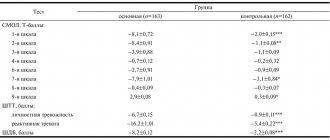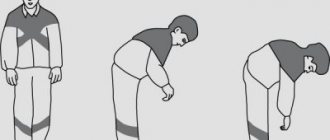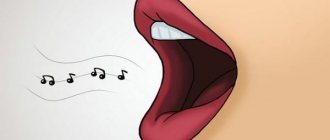Neuromuscular relaxation, according to the method of the American doctor Edmund Jacobson, is an excellent method of self-regulation that allows you to relax without the use of sedatives. Psychological stress is the scourge of modern society. Nervous tension negatively affects not only performance, but also human health.
A state of anxiety prevents you from concentrating on completing tasks and leads to absent-mindedness, insomnia and depression. Anyone can learn to get rid of emotional stress. The essence of the Jacobson method is simple, and the exercises are easy to do.
The essence and basic principles of neuromuscular relaxation according to Jacobson
As a result of daily psychological stress, an adult accumulates such a reserve of emotional stress that even before going to bed, while at rest, he cannot feel complete relaxation.
At the beginning of the 20th century, the American physiologist and psychiatrist Edmund Jacobson actively began studying the relationship between the muscular and psychological state of the body. His research has proven that complete muscle relaxation helps relieve emotional excitement in the nervous system. Jacobson's developments became the basis for a new technique called Progressive Muscle Relaxation.
Jacobson neuromuscular relaxation was developed by psychiatrist Edmund Jacobson in the early 20th century.
Neuromuscular relaxation according to Jacobson is a set of exercises aimed at relieving tension. The exercises consist of alternating controlled tension and relaxation of certain muscle groups.
The essence of the method is based on the following principles:
- after strong tension, the muscles tend to relax;
- Complete physical relaxation is followed by a decline in emotional activity, due to which a state of rest is achieved.
The exercises developed by Jacobson are simple and accessible to people of all physical abilities. Their use in a stressful situation allows you to quickly calm the nervous system and take control of emotions. The popularity of the technique is growing every day.
This is not surprising, because it has a number of undeniable advantages:
- efficiency;
- simplicity;
- versatility;
- speed of achieving results.
After 3-4 weeks of regular exercise, the action algorithm is remembered at the subconscious level. When a stressful situation occurs, the release of emotional tension through neuromuscular relaxation occurs automatically.
Benefits of muscle relaxation for humans
Relaxation (from the Latin relaxatio “relaxation”) is a decrease in skeletal muscle tone, which is achieved with the help of special techniques, exercises, physiotherapy and medications.
Relaxation is especially important for those who have increased muscle tension or a tendency to sudden changes in muscle tone, which leads to various diseases.
Good tone is a balance between muscle tension, contraction and relaxation. If it is followed, then the human body remains strong and flexible, but in fact most people experience muscle tension. And this applies not only to those who are interested in sports, but also to those who are constantly in an unstable emotional state.
The causes of muscle tension are:
- Stressful situations: the muscles of the neck and shoulders, pelvic area and solar plexus area react to stress. Surely, before an exciting event, you felt as if a weight was hung on your shoulders or spasms appeared in the abdomen or chest, which made it even difficult to take a breath. It was so?
- Hypothermia: a person, when faced with cold, is forced to retain heat inside himself by tensing certain muscles. Therefore, those who live in cold regions often experience muscle spasms, tightness and pain.
- Sedentary lifestyle: we spend most of our lives in front of a computer at a desk or in a vertical position if work requires us to be on our feet. Can you imagine how stressful this is for our muscles? After all, probably not everyone watches their posture and periodically does a warm-up.
- Increased physical activity: have you noticed how after a long workout some muscles begin to ache? Such pain does not always indicate the benefit of the work done, or rather, its cause may just be the incorrect technique of performing physical exercises [A. Vladimirova, 2020].
When a muscle spasms, the capillaries are compressed and the outflow of blood is disrupted, i.e. oxygen and glucose begin to flow in insufficient quantities. As a result, metabolic products accumulate, swelling appears, which causes pain. And if the clamp is not removed, there is a risk of cell destruction. Muscle tension has a negative impact on sleep, performance and can cause apathy and irritability.
Muscle tension makes it difficult for nutrients to reach the internal organs, which causes a decrease in immunity and worsens the external condition. Can you imagine what will happen to your face in a couple of years if you constantly strain its muscles? Simply put, the ability to relax muscles maintains health, beauty and helps maintain emotional well-being. That is why it is important to monitor muscle tone and maintain its balance [V. Varygin, 2021].
To relax the muscles, it is not always enough to take a vertical position and get enough sleep, because the situation can be so advanced that even in sleep the body cannot enter a state of relaxation.
There are several techniques that help relax muscles:
- Osteopathy: a type of alternative medicine that implies that there is a certain connection between the functioning of organs and the musculoskeletal structure. Osteopaths relieve muscle tension by first determining the cause and source of tension.
- Massage: Another relaxation technique. It is less precise than osteopathy, but more pleasant.
- Thermal procedures: if cold causes muscle tension, then heat helps to relax them, so warm baths and saunas will come in handy if there are no contraindications [A. Vladimirova, 2020].
But there are several more effective relaxation techniques developed by scientists that you can put into practice yourself. Let's take a closer look at them.
Indications for starting the use of neuromuscular relaxation according to Jacobson
Neuromuscular relaxation according to Jacobson is indicated in situations involving the occurrence of strong emotional stress.
For example:
- passing exams, defending diploma projects;
- passing important interviews, the first working day in a new position;
- speaking before the public (relevant for aspiring politicians and artists).
For therapeutic purposes, a set of exercises is recommended for people with the following deviations:
- tendency to panic attacks, increased anxiety;
- the presence of phobias, difficulties with socialization and adaptation to new conditions (change of job, place of residence);
- drug, nicotine, alcohol addiction;
- emotional instability, tendency to aggression.
For preventive purposes, neuromuscular relaxation can be useful even for absolutely healthy people who have jobs that require increased moral and financial responsibility, or who lead a sedentary lifestyle.
Contraindications to performing neuromuscular relaxation according to Jacobson
The Jacobson neuromuscular relaxation complex includes 12 exercises to relax the muscles of the legs, arms, abdomen, back and face.
Since the technique is universal, the list of contraindications for its use is minimal and consists of 2 points:
- physical pathologies of body parts or internal organs;
- Age restriction: not recommended for children under 12 years old.
What about yoga and meditation?
Yoga is one of the most popular and fashionable areas, which includes various practices that help normalize the state of the body, including the physical one. But the main task of yoga is to teach you to control your psycho-emotional state and relax. The greatest effect can be achieved if you combine yoga and meditative exercises that are aimed at working with the subconscious.
There are several basic relaxing meditative asanas that you can perform at home on your own:
Padmasana – Lotus Pose: This is one of the main asanas in yoga. Scientists consider it the most suitable pose for meditation. How to do it: sit on the floor or mat, cross your legs (your feet should be on opposite thighs and your knees should touch the floor), put your hands on your knees, keep your back straight, close your eyes and completely relax your body. The asana develops a sense of balance, relaxes muscles, leads to deep relaxation, calms the nerves and normalizes the cardiovascular and respiratory systems through slow breathing.
Siddhasana – Half Lotus: This is a simplified version of the lotus pose. Here, only one foot is placed on the thigh, and not both, as in the previous case. How to do it: sit with a straight back, bend your knees, press one foot to the perineum and to the floor, and place the other on the calf of the opposite leg, trying to reach your thigh with your fingers; Place your palms on your knees and make a circle with your thumb and forefinger; tilt your head to your chest, relax your neck and close your eyes. The benefits of this asana are identical to those of the lotus pose: the main effect is on strengthening the muscles of the back, spine and improving joint mobility.
Sukhasana: This asana is also called “Turkish pose”. Beginners are recommended to start practicing yoga with it, because... it is simpler than the asanas described above. Everything is very easy: get down on the mat, bend your left leg at the knee and press your foot to your thigh as close to your groin as possible; Bend your right leg too and place it on the floor parallel to your left and spread your knees wider.
Vajrasana: kneel down and “place” your pelvis on your heels, place your right palm on your right knee, your left palm on your left. The head, neck and spine should be in a straight line and vertical at all times. Relax your muscles, close your eyes and breathe slowly. Despite the fact that the exercise requires complete muscle relaxation, it strengthens the spine, leg muscles and makes the leg joints more flexible.
Shavasana (“dead pose”): this pose is one of the most important in yoga, because... helps achieve complete relaxation. Technique: lie on your back, stretch your arms along your body, but do not touch your body; spread your legs slightly to the sides, close your eyes and alternately relax the muscles of your arms, legs, pelvis, back, abdomen, chest and shoulders, and at the very end, relax your face and neck. You can do this exercise as much as you want, and when you come out of it, tense your muscles well and slowly stand up.
There are no contraindications for performing this asana. This is the best exercise for relaxation after mental and physical stress.
If you are new to yoga, then start with short practices: 1-2 minutes for each asana, gradually extending the time to 30 minutes [I. Kriksunova, 2018].
Yoga involves natural muscle relaxation through complete immersion in the process and achieving internal balance. If you perform asanas regularly, then a bonus to all the benefits of exercise will be the development of body flexibility.
Practice meditation before and after yoga, such as breathing exercises. This will help you relax faster. Or perform the “Ajapa-japa” (“Mantra-meditation”) technique: take a comfortable position. You can lie down or stand up, the main thing is that your back should be straight. Focus on your breathing, feel how the air passes through your nostrils or how your stomach and chest move as you breathe.
Then concentrate on the sound of air entering and leaving your nostrils. When you inhale, pronounce the syllable “so”, and when you exhale, pronounce “ham”. These sounds are similar to the natural sound of breathing. Your task is to hold the sensation of breathing, its sound, and at the same time repeat these two syllables to yourself. It is recommended to perform this practice for 5 minutes or more [M. Gorshetchenko, V. Zobnina, 2020].
By the way, have you heard anything about post-isometric muscle relaxation? The main meaning of such relaxation is a combination of isometric muscle tension (at this stage the breath is held) and their further stretching (occurs as you exhale in a relaxed state). As a result of such manipulations, hypotension is achieved - muscle relaxation.
Let's look at how to achieve post-isometric relaxation using the example of Hatha yoga asanas:
- Iliopsoas muscle: Lie on your back, bend your left knee and clasp your knee with both hands. The right leg should lie straight on the surface. As you inhale, lift your right leg off the surface for 5-7 seconds. As you exhale, lower your right leg to the floor and pull your left knee towards you.
- Gluteus maximus: Lie on your back, bend your left leg at the knee and clasp it with your hands under the knee. Place the foot of your right foot on the knee of your bent leg (the bent leg should lift off the floor surface). As you inhale, apply resistance with your right foot to your knee (no more than 7 seconds). As you exhale, pull the “structure” towards you. Repeat the technique with the other leg [Yu. Kukoleva, 2021].
You can find many video tutorials on this topic on the Internet. Look at this one for example:
Psychoisometric muscle relaxation is used not only in yoga, but also as a separate relaxation technique.
Don’t forget that the point of such practices is complete mental and physical relaxation. If you fail to “switch off” during exercise, you will not be able to achieve the desired effect.
Useful tips for patients
To increase the efficiency of the complex, you should adhere to the following rules:
- Before starting relaxation, you need to get rid of clothes and shoes that restrict movement, as well as take off your watch, glasses or contact lenses.
- Before taking the starting position, it is recommended to do a short warm-up, which will warm up the muscles of the legs and arms, reducing the risk of cramps.
- Perform each stage of the exercise in 4 counts: increasing tension in the muscles while inhaling, concentrating at maximum tension while holding your breath, relaxing while exhaling.
- Maximum muscle tension should be followed by relaxation. It is recommended to repeat the exercise 2 times. If there is a feeling of residual tension in the muscle tissue, you can increase the number of repetitions to 7.
- Muscle tension should not be accompanied by cramps or pain. If this happens, it is necessary to reduce the intensity of the exercise, or completely abandon it.
- For better memorization, it is recommended to master exercises for different muscle groups one by one, with an interval of 4 days. This makes it possible to launch a muscle memory program and bring the execution of each technique to automaticity.
- After each repetition, you need to concentrate on the sensations in the muscle group on which the exercise was performed.
It may take 15 to 20 minutes to complete all the exercises. It is recommended to conduct a session of neuromuscular relaxation in a calm environment with appropriate musical accompaniment (sounds of the forest, sea, music for meditation).
Relaxation is just relaxation
Relaxation can also consist only of relaxing the muscles, while completely ignoring the process of tension. Complete relaxation of the body also has a positive effect on releasing negative emotions. For this practice, you need to slowly start the process of relaxation in the body, concentrating on individual parts of it - from the face to the tips of the feet.
It should be noted that this simple task traces the relationship between the process of relaxation and meditation, for which you should act in accordance with the following algorithm:
- Having taken a comfortable position, close your eyes;
- concentrate on your breathing, noting that your inhalation is equal to your exhalation;
- gradually plunging into a state of relaxation, it is necessary to monitor whether there is any tension left in some parts of the body and, if there is any, to direct maximum relaxation to this area of the body;
- the relaxation process can be combined with visualization, which will help keep the mind active and avoid falling asleep; by visualizing, you can imagine how with every inhalation the body is filled with positive energy, and every exhalation cleanses you of negativity;
- the time spent in a state of relaxation can vary from 5 to 20 minutes;
- after the time specified above, you should slowly come out of the state of relaxation and if you took the lesson from a lying position, turn on your left side, lie down for a while with your eyes closed, and then through a deep breath return to reality and open your eyes.
Using this type of relaxation to relieve stress allows you to quickly relax and, filled with new strength, begin your daily activities.
The main set of neuromuscular relaxation exercises according to Jacobson
The goal of the exercises developed by Dr. Jacobson is complete relaxation, helping to relieve nervous tension.
The complex can be divided into 4 blocks:
- arms and shoulders;
- neck, back of the head and facial muscles;
- back and stomach;
- legs.
Each block contains from one to 3 exercises that are done in a sitting position. All exercises are performed according to a three-stage scheme: tense - feel - relax. Then analyze the difference between a tense state and a relaxed state. This approach helps to get maximum pleasure from relaxation.
| Exercises to relax the arms and shoulder girdle | Clench your hands into fists. Feel your fingers and forearms tense. Hold the position for a few seconds, then slowly relax your hands. Bend your elbows to the limit. Feel the tension in your biceps. Fix the position, and then slowly straighten your arms, relaxing them. Raise your shoulders up. Try to achieve maximum lift. At the highest point, fix the position, feel the stretching of the tendons and the tension of the muscles of the shoulder girdle and neck. Then slowly lower your shoulders and relax. |
| Exercises for the neck, back of the head and facial muscles | Tilt your head down. Try to pull your chin to your chest as much as possible, feel how your neck muscles tense. Fix the position, then slowly raise your head. Raise your eyebrows, while tensing your forehead muscles as much as possible. Feel the tension. Fix the position, then relax. Wrinkle your nose tightly. Feel how the muscles of the harmful part of the face tense. Hold the position, then slowly relax. Clench your teeth tightly. Stretch the corners of your lips into a smile. This grimace will cause tension in the cheeks, chin and cheekbones. Hold the position, then slowly relax. |
| Exercises for the back and abdomen | Squeeze your shoulder blades together as much as possible. Fix at the point of maximum tension, then slowly relax. Next you need to tense your stomach. Feel how the abdominal muscles tighten from tension. Wait a few seconds, then relax. |
| Leg exercises | Place your heels on the floor and tighten your thigh muscles. Feel the muscles become toned. Fix the position, then slowly relax your legs. Pull your socks towards you. Feel the heel tendons stretch and the calf muscles tighten. Fix the position, then slowly relax your legs. Tuck your toes, feel the tension in the plantar muscles and tendons of your foot. Fix the position, then slowly unclench your toes, relaxing your foot. |
On the Internet you can find several variations of neuromuscular relaxation complexes, different in composition, but the same in implementation methodology. If any of the suggested exercises cause spasms, pain or cramps, they need to be replaced. Between blocks you need to take a relaxation break of 20-30 seconds.
After completing the set of exercises, you need to close your eyes and take 2-3 deep breaths. Listen to your feelings, feel how a wave of relaxation slowly moves through the body from the hands to the shoulders and head. Then from the back to the stomach and legs. Before opening your eyes, it is recommended to slowly count backwards from 10 to 1.
How the technique works
In order to explain the algorithm of operation of the muscle relaxation technique, it should first be said that Jacobson relied on the fact that the human muscle structure is divided into certain groups, and exercises were arranged in the same sequence in accordance with them. Thus, the progressive relaxation complex was performed in the following sequence:
- arm muscles;
- forehead muscles;
- neck;
- rib cage;
- stomach;
- lower limbs.
Muscle relaxation begins with short-term (up to 5 seconds) muscle tension, which then relaxes, and a person’s attention shifts from tension to the feeling of relaxation that arises in the body.
For those who are just starting to practice this method, during the first lessons a training practice is carried out, accompanied by detailed instructions on the order of the exercise and the change from tension to relaxation. Instructions created for self-development of a progressive relaxation method, first of all, suggest choosing a comfortable place and a comfortable body position, and then, having closed your eyes first, pay attention to how you breathe.
In general, the technique consists of several stages, each of which is represented by a specific algorithm of actions. So at the first stage, a person should lie on his back, bend his elbows and tense his arm muscles in such a way as to feel a strong tension. Afterwards, the arms should be sharply relaxed, directing attention to the state of the body. The exercise is repeated 3 to 5 times.
At the first stage, another exercise is performed, the essence of which is to contract and relax the biceps, which must be strong enough in order to then trigger the same strong relaxation into the muscles. Next, the torso, neck, shoulders, facial muscles, eyes, tongue, and throat are worked out in the same way.
At the second stage, having assumed a sitting position, you should create tension and relaxation in the muscles alternately, using only those muscles in the exercise that do not support the body in a standing position. Next, it is proposed to perform exactly the same manipulations with muscles that are not involved in activities such as reading, writing, speech, and the like.
At the third stage of progressive relaxation, the time of introspection begins, because It is required to note and remember those muscles in which tension occurs most when a person experiences negative emotions or physical pain. Then, by relaxing those parts of the body that are most tense, you can learn to get rid of negative conditions.
To summarize, we can say that the basis of the Jacobson relaxation technique is the work of consciousness and control of your body with its help. Also, it is worth saying that, despite the technique not being tied to certain conditions, at least at first, in order to successfully practice this method, you should choose the right place, which should be quiet and not brightly lit, you should also ensure that the body was not constrained by tight, tight-fitting clothes.
In addition to the above, it is not recommended to perform exercises immediately after eating, on a full stomach.
Consolidate the result
Jacobson's neuromuscular relaxation requires self-discipline. To fully master the method, it will take 10 to 12 weeks of daily training. In the first month it is recommended to exercise 2 times a day, in the second you can switch to one-time workouts.
Further, it is allowed to reduce the intensity of training to 2 times a week. If you are persistent enough, the effect of muscle memory will work, and when a stressful situation arises, the relaxation mechanism will start automatically.
Opinions about neuromuscular relaxation according to Jacobson of doctors and patients
Experts believe that Jacobson's method is ineffective in cases of panic attacks, deep depression and dysphoria. Its effect is often compared to the effect of an antipyretic, which relieves fever but does not solve the problem. According to doctors, neuromuscular relaxation can be considered as a component of complex therapy in the treatment of nervous disorders.
However, even professionals cannot help but recognize the positive impact that this technique has on patients.
Those who have long used neuromuscular relaxation according to the Jacobson method to combat stress, insomnia and constant feelings of anxiety speak more optimistically about it. Visitors to numerous forums dedicated to discussing topics in the fight against psychological disorders note positive changes within a few weeks after the start of classes.
Summarize
The most common cause of muscle tension is stress. This is understandable: today’s rhythm of life presents us with various surprises, which we cannot always avoid. As soon as you allow negative thoughts or fear, the body immediately turns on the readiness mode to fight the enemy, tensing its muscles. It’s not for nothing that they say that all diseases are caused by nerves, because in this way we do not allow the body to function properly and disrupt its natural processes.
In fact, everything is simple: to eliminate pain and spasms in muscles and relax, you need to identify the source of anxiety and learn to control your emotions. Just for this, we have an online program “Mental Self-Regulation”, where you will learn to cope with stress, difficult relationships, anxiety and fear and other “inhibiting” factors.
Avoid physical overload, don’t get nervous over trifles and remember that your health is a treasure and needs to be protected!
Good luck!
We also recommend reading:
- Storytelling
- Isometric exercises
- How to learn to relax: effective relaxation techniques
- Is it possible to do without a psychotherapist?
- The main ideas of Konstantin Stanislavsky
- Methods of mental self-regulation: save yourself
- 10 Popular Exercises to Relieve Stress
- Spotlight effect
- Systematic desensitization of Joseph Wolpe
- How to run correctly
- What to do with psychological problems?
Key words:1Psychoregulation
When should you expect the effect of neuromuscular relaxation according to Jacobson?
The results of neuromuscular relaxation exercises depend on the individual characteristics of the patient and the level of overexertion. If there is emotional stress associated with everyday problems, work conflicts or minor financial difficulties, the effect can be noticeable within a couple of weeks.
However, in cases of deep depression and more serious nervous disorders, this technique may not be enough to achieve the required level of relaxation.
Regular practice of neuromuscular relaxation using the Jacobson method develops the habit of quality rest, which helps reduce emotional excitability and increase stress resistance. This method of self-regulation has a beneficial effect on the strength of mind and body, quality of life, performance and relationships with others.
Article design: Oleg Lozinsky








